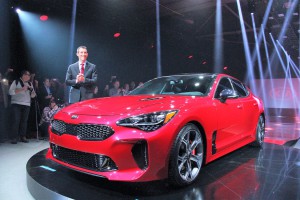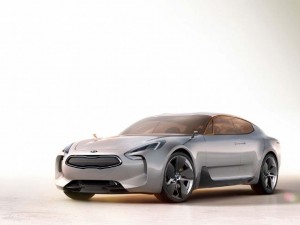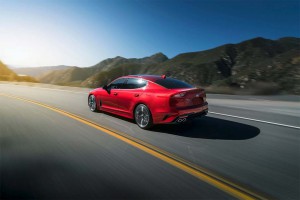If there’s anyone left who thinks Kia is all about mundane econoboxes they’re in for a shock when they get a good look at the Korean carmaker’s new Stinger sport sedan.
The fastback is based on the wildly popular Kia GT that made its original debut at the Frankfurt Motor Show in September 2011, the work of Kia’s design chief – and now vice chairman of both Kia and sibling Hyundai – Peter Schreyer.
Offered with a choice of turbo-four or twin-turbo V-6 options, the new five-door gran turismo debuting at the North American International Auto Show promises to be not just one of Kia’s most visually distinctive models, but also its fastest. It will also be one of the automaker’s most lavishly equipped offerings when it hits the road later this year.
“Unlike any Kia that has come before it, the Stinger really is a dream car for us, and here today in Detroit, that dream is now a reality after years of commitment and hard work,” said Orth Hedrick, vice president of product planning for Kia Motors America.
(Kia bringing new Picanto to Geneva Motor Show. Click Herefor the story.)

The Kia Stinger will be offered with a choice of two powertrains, including a 367-hp twin-turbo six.
When it made its Frankfurt debut, few took the original GT concept to be much more than a fantasy in chrome, certainly not at a company traditionally known for its focus on mainstream transportation. But that image has undergone a rapid change since Kia lured Schreyer away from Audi. And as the German designer gets set to retire later this year, the Kia Stinger is likely to be viewed as one of the high points of his career.
Stinger picks up on some of the more distinctive cues of the original Kia GT, including the steeply raked windshield, fastback roofline and a lower, wider take on the brand’s trademark ‘tiger nose” grille. One critical difference: there are traditional sideview mirrors, rather than the streamlined cameras on the concept vehicle. And there are new headlamps, reflecting the big leaps in lighting technology since the GT concept first debuted five years ago.
(Click Here to preview all the new cars, trucks and crossovers debuting in Detroit.)
There’s a muscular exuberance to the Stinger, though it eschews the over-the-top angles and curves found on many other high-performance GTs and sports cars.
There’s an emphasis on functionality with many of the design cues, including the front air curtains, wheel arch gills, smooth underbody, and integrated rear diffuser, Kia notes.
In proper GT form, the Kia Stinger has a cab-rearward layout, further emphasizing the car’s power. The seats are deeply contoured – and can be ordered in Napa leather, and with optional air bladders for improved support under aggressive driving conditions. Through the thick, leathered-wrapped steering wheel , the driver has a good view of the combination digital and analog gauges, all clustered under a single binnacle. Those gauges provide the normal mix of driver information, as well as G-forces, lap times and oil temperature.
The Stinger measures 190.2 inches, bumper-to-bumper – longer than the Audi A4, Lexus GS and Mercedes-Benz CLS — and has a 114.4 wheelbase. At 73.6 inches, it’s also wider than most cars in its segment.
It rides on a unique chassis featuring 55% high-strength steel for improved rigidity, Kia claims. There’s a MacPherson strut suspension up front, with a multi-link design in back. And, for the first time from Kia, ride-damping and vehicle handling settings are driver-adjustable. There are five driver modes: Personal, Eco, Sport, Comfort and Smart.
Buyers will have a choice of two powertrains to motivate the Stinger: the stock turbo 2.0-liter four-cylinder Theta II engine makes an estimated 255 horsepower and 260 pound-feet of torque. For maximum performance, there’s a 3.3-liter twin-turbo V-6 Lambda II engine, which is expected to produce 365 hp 376 lb-ft. The six is expected to hit 100 kmh, or 62 mph, in 5.1 seconds, with a top speed of 167 mph.
Both engines share an eight-speed automatic first used in the Kia K900 luxury sedan. It’s Kia’s first gearbox to feature a Centrifugal Pendulum Absorber. Commonly used in motor sports, it helps reduce powertrain vibration.
From a safety standpoint, the Kia Stinger will feature such advanced-driver assistance system, or ADAS, technologies as forward collision assistance with autonomous emergency braking, lane keep assist, rear cross traffic alert and the new Driver Attention Alert, a system designed to prevent drowsy driving.
In the cabin, there’s the requisite infotainment system, a head-up display, or HUD, a wireless smartphone charging pad and a choice of audio systems that includes a 720-watt, 15-speaker Harman/Kardon set-up.
Kia plans to announce pricing closer to the Stinger’s on-sale date later this year.
(To see how Kia is putting a little zip into the new Soul, Click Here.)



